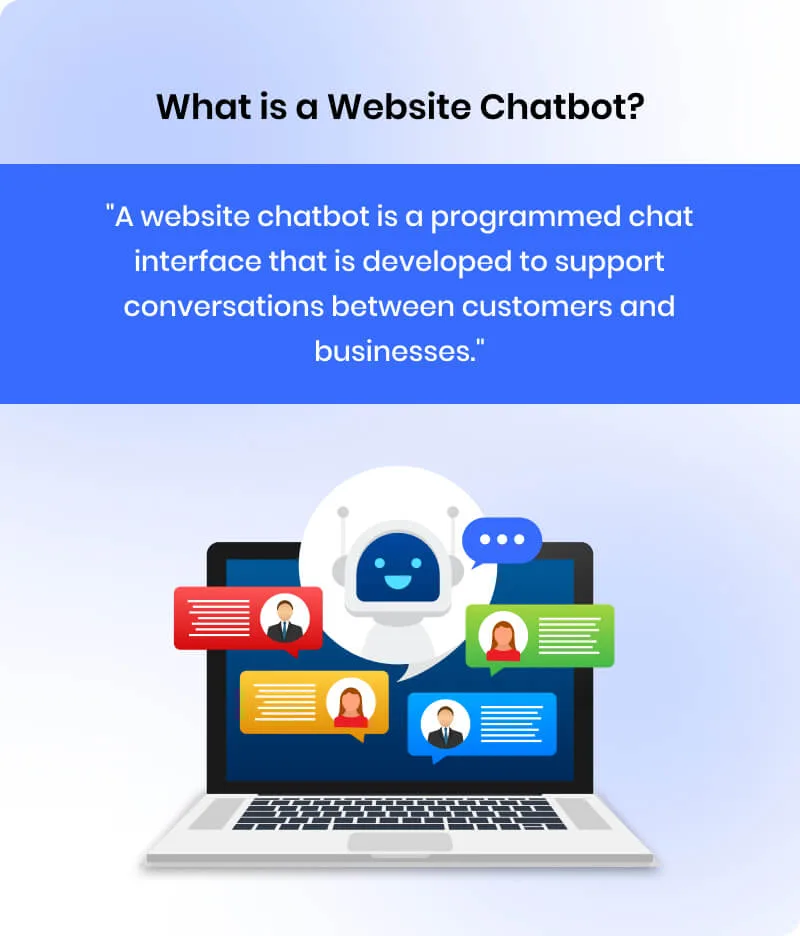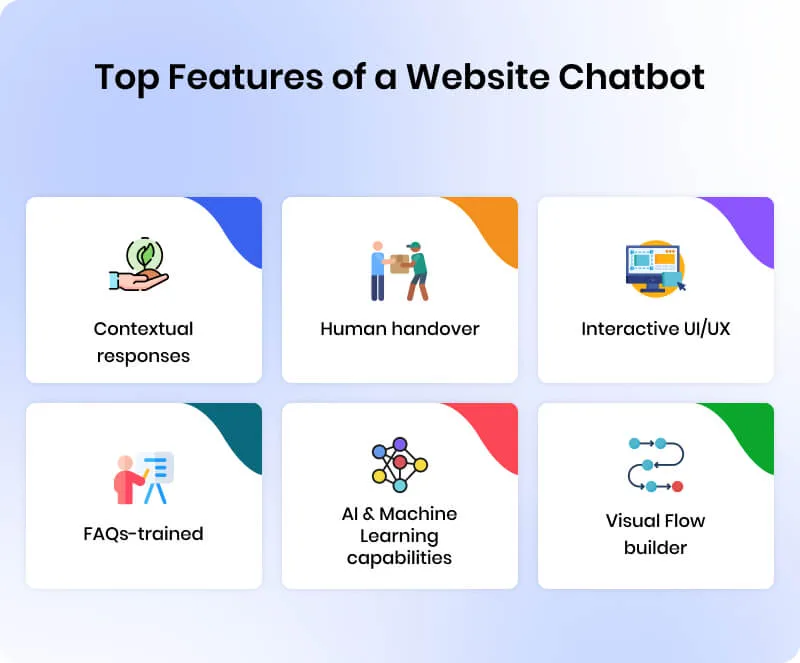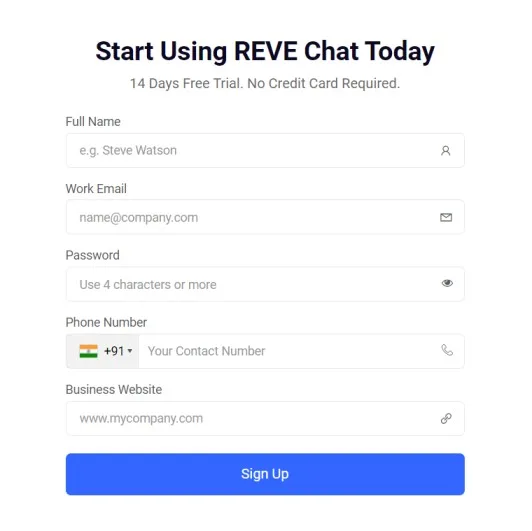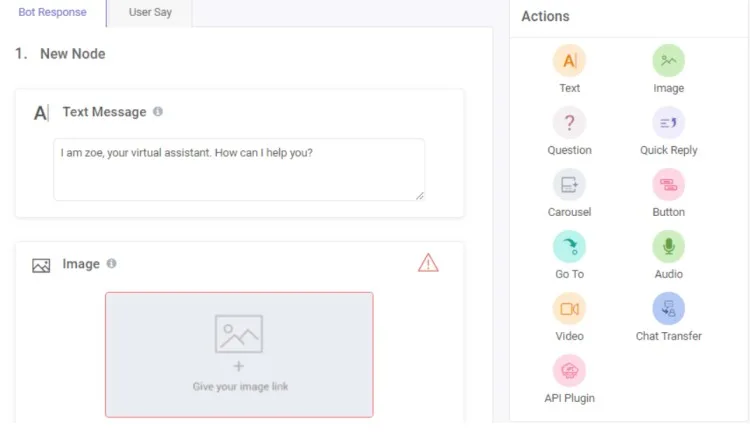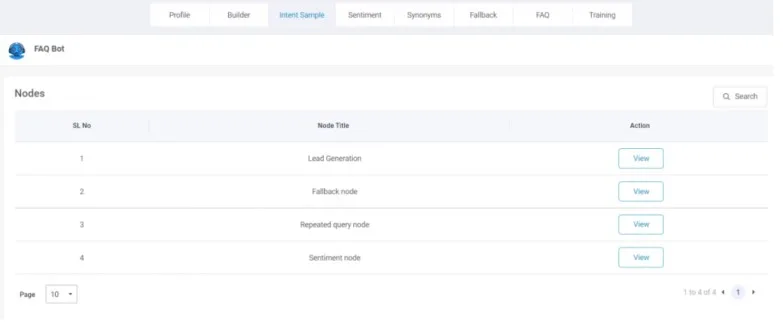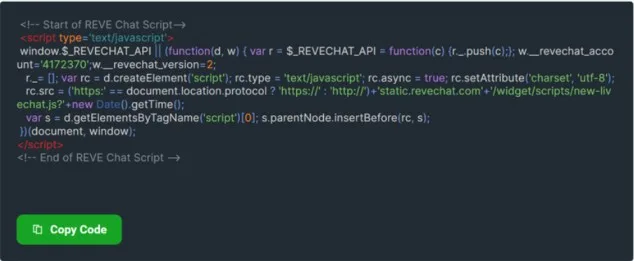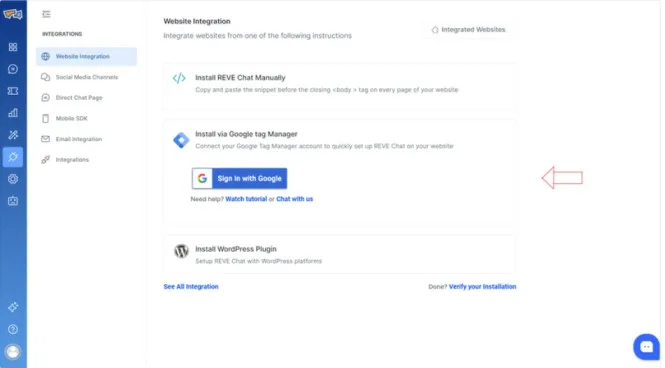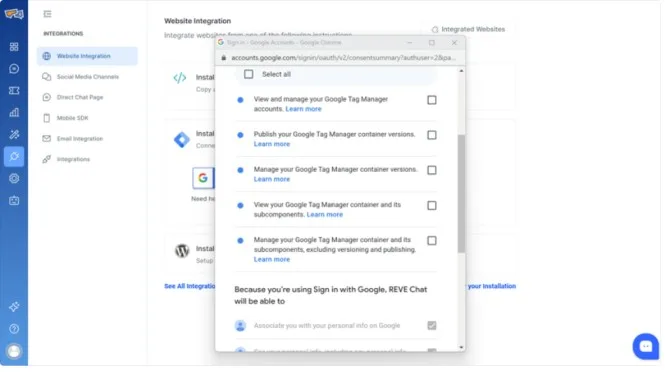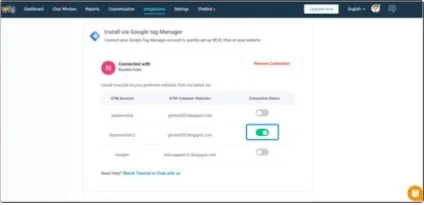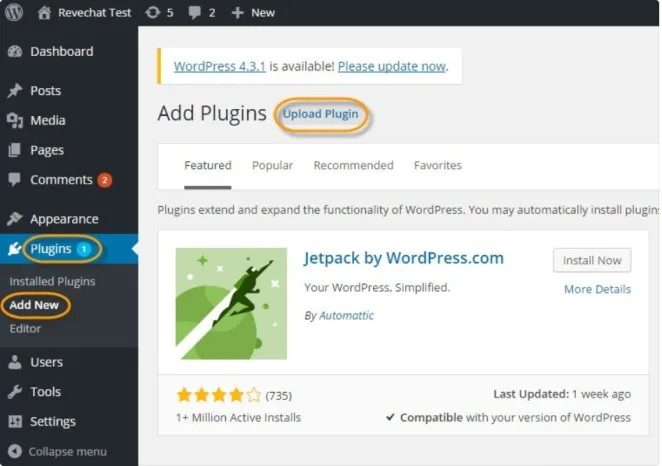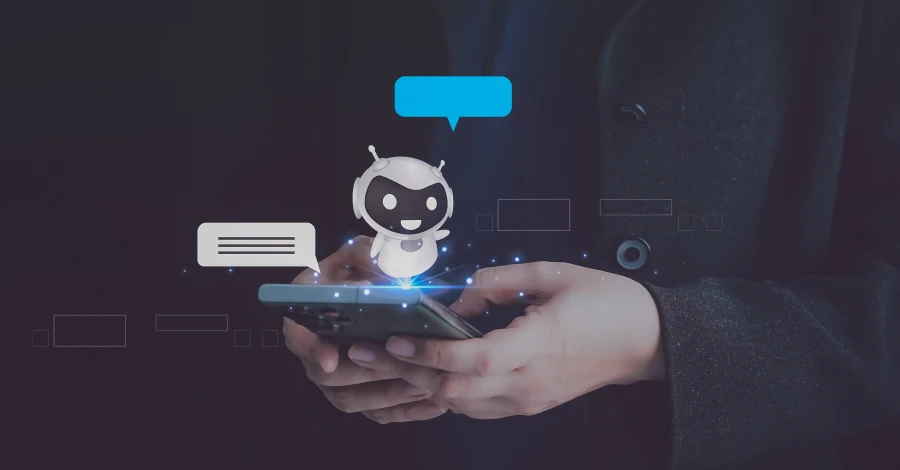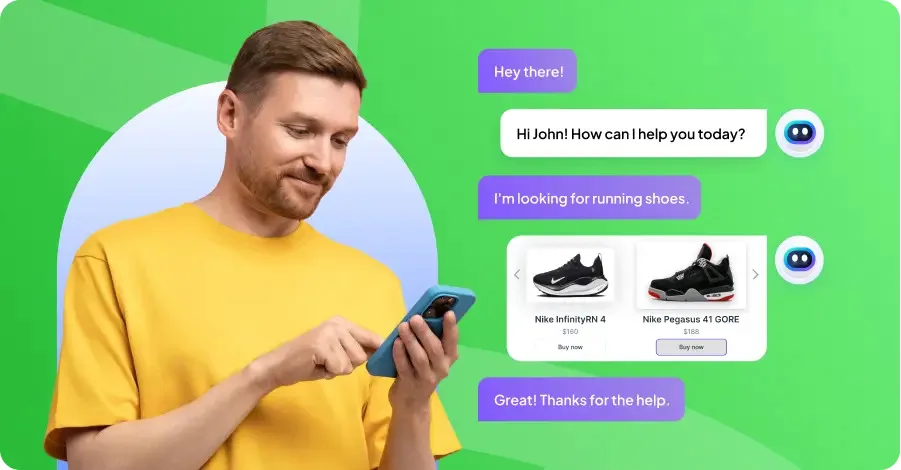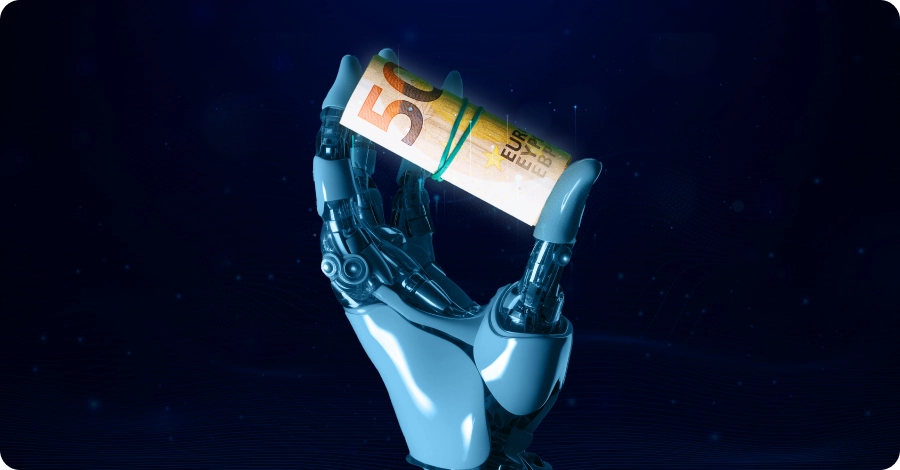Website Chatbot: Key Features, Benefits & Use Cases
- June 30, 2022
- 24 mins read
- Listen

Websites have a big role in the growth and success of a business. They help brands engage and convert visitors. In addition, a website can be used for a variety of tasks across marketing, sales & support. For that reason, most businesses want their websites to become more powerful and have more features.
This is where a chatbot can help.
A website chatbot can greatly add to the potential and features of a website and make it more beneficial for the business. It can provide an edge to the business by automating tasks across departments, resulting in improved engagement and more leads.
What’s more, chatbots these days are quite advanced and come with artificial intelligence (AI) and machine learning (ML) capabilities. This helps them with language understanding and empowers them to mimic humans’ conversational ability.
On top of that, more than 50% of enterprises plan to spend more on bots and chatbot creation in the future. Maybe they already understand how website bots can prove handy in customer service and support tasks.
In this blog, we explore AI chatbots for websites in detail, understand their benefits, and use cases, and also learn how to create one for your website.
Before delving deeper, let’s first understand the definition of a website chatbot…
What is a Website Chatbot?
A chatbot is a programmed chat interface that is developed to support conversations between customers and businesses. When deployed on a website, it can enable visitors to interact with the business conversationally.
A website chatbot can closely mimic the way humans converse and facilitate a two-way conversation. It’s programmed to respond to queries on its own. Since an AI bot can respond to queries and understand natural language, it has become a great tool for customer service and engagement.
Using a website chatbot, your customers can easily find solutions to their problems related to your product or service. This is how customers on the website get their issues fixed without any human intervention, and easily access all the information there.
A chatbot for a website can either be rule-based or AI-based. When it’s rule-based, the responses will follow the rules it’s being built with. On the other hand, an AI chatbot for a website is advanced in nature and can handle complex conversations without any rules.
Key Features of a Website Chatbot
A smart chatbot has all the advanced features of a modern tool for delivering and supporting conversational experiences. It combines the right kind of technology, flow, and design to handle customer-to-business interactions without requiring any human assistance.
A good example is the REVE chatbot whose features are top-class and ensure value to businesses in diverse areas. Some of its top features include –
- Contextual responses – The chatbot uses advancements in natural language processing (NLP) which makes it able to understand the context and deliver responses like a real person.
- Human handover – A good chatbot is often intelligent enough to sense the complexity of a conversation and smartly hand over the conversations to human support when it does not grasp the query.
- Interactive UI/UX – Conversations feel interactive when the chatbot design is simple and intuitive as then users find it easy to use them for answers.
- FAQs-trained – The bot can be trained regularly to become powerful, support FAQ automation easily, and handle questions and interactions in a hassle-free manner.
- AI & Machine Learning capabilities – The chatbot is designed using AI and machine learning technologies, can comprehend user conversations and respond in real-time, and ensure personalized experiences in different tones and languages.
- Visual Flow builder – Top bots come with the option of zero or no-code development so that anyone can create the bot flow with the help of nodes and actions like text, image, and carousel.
Steps to Create Chatbots for Website
You can build a chatbot without advanced coding skills. There are chatbot builder platforms that help you build conversational bots without writing a line of code. Once the bot is developed, you can deploy it as a virtual assistant on your website for various tasks be it customer service & engagement, lead generation, marketing, and so on.
To create and start using a chatbot platform, you need to follow the below-mentioned steps –
Step 1 – Define your goals
A chatbot can perform a variety of tasks and add value to your website (and business) in many ways. However, you should first set clear goals and then identify the tasks you want the bot to perform. When you have defined goals, it will help you leverage the chatbot’s true potential and functionalities.
By using a chatbot on the website, you can do –
- Automate support by answering routine, or frequently asked questions (FAQs) of customers
- Stay available for customers round the clock and provide 24/7 customer support
- Help website visitors navigate through the website
- Help customers with troubleshooting and technical support
- Schedule appointments, fix booking and reservations
- Send updates, notifications, and reminders related to any aspect of the business
- Collect customer feedback and data for customer insights
So, you first decide what you want the chatbot to do and then move to the development part.
Step 2 – Customize your bot profile
Customers still prefer humans over bots for engagement and support for complex issues. That’s why you should focus on keeping the bot more like humans. You can customize the bot profile and make it feel more natural for customers, resulting in a friendly experience for users.
You can log in to your bot dashboard, create a new bot, and customize its profile. You can work on various aspects like the tone, personality, style, and the right language. All this will help the bot to engage, interact, and communicate with customers naturally.
You can customize a few of the bot profiles –
- Bot Name: You can name the bot for internal business purposes. This name won’t be visible to your customers. E.g. Sales or Customer Service bot.
- Display Name: You can name your bot in a way that fits your personality or business needs. For example, Eva or Zoe. When customers see the name, they feel as if they are interacting with a human agent.
- Tagline: You can set a designation for the chatbot, which can also be displayed to visitors and customers.
- Bot Avatar: The bot can be personalized by choosing an avatar from the gallery or by uploading one of your choices.
- Enable Channels: With a chatbot platform, you can choose your preferred channel to deploy the chatbot for 24×7 assistance. The channel choices include (i) Website (ii) Facebook (iii) WhatsApp (iv) Viber.
- Bot Accuracy Levels: Here you need to select the query matching the accuracy level in percentage.
- Set Priority of Bot and Human Agents: You can choose from the three options to set the priority of bot and human agent for seamless communication.
Step 3 – Set triggers for your chatbot
You can set triggers for your chatbot and decide when it should interact and engage with visitors. Based on the chat triggers you set or choose, the bot will converse with visitors on the website.
You can set triggers in different ways –
- You can set triggers in a way that you bot chats with all visitors to your website.
- You can set triggers in a way that the bot chats with new visitors only.
- You can set triggers in a way that the bot recognizes old visitors and chats with them.
Step 4 – Build the flow of your chatbot
How your chatbot converses with users will depend on the flow of your chatbot. Creating a conversational flow can help you organize the bot’s responses clearly and logically. You need to plan the bot’s conversation paths, including responses, actions, questions, and greetings.
Building the flow of the chatbot is also essential for aligning the bot’s response to each user interaction. You need to plan and build possible interaction scenarios and anticipate user responses and branches.
You need to define a bot flow with nodes and actions. When using a chatbot builder, you will have various nodes and actions to define your bot flow accordingly.
Step 5 – Create intent samples
A chatbot can respond logically only when it understands why users send messages. It can maintain relevance only when it recognizes the user’s purpose or intention. That’s why you need to create an intent sample for your bot.
The intent sample will help your bot understand the reason behind a query. It will help you provide the bot with different reasons or scenarios when customers reach out for assistance.
In the chatbot builder platform, you can create new nodes for creating intent samples. You have to enter sample queries having the same meaning that covers customer intention while interacting with the bot.
When you enter the sample queries, a list is created that is used by the bot to handle customer service conversations.
Step 6 – Develop the bot’s emotional intelligence or sentiment analysis feature
AI chatbots for websites can understand and comprehend emotions from text, or voice data. They can do that only when you develop their emotional intelligence or sentiment analysis feature.
A bot with the sentiment analysis feature can analyze sentiments, thoughts, and opinions from the files or responses they get. It can recognize negative or offensive words and emojis.
The bot builder will let you add offensive words and emojis for your bot so that it can identify the user’s sentiments during the conversation. From the dashboard, you can configure the bot to respond to offensive words or transfer the conversation to a human agent.
Step 7 – Feed the synonyms
Once the bot’s intelligence is developed, you move on to the next step, setting up synonyms. With this step, you will empower your bot to understand all the synonyms of a word or jargon used by the customer and then match them with the corresponding knowledge base.
Step 8 – Define the fallback options
No matter how advanced a chatbot is, it can never respond accurately 100% of the time. There will be situations when it fails to understand the user query and therefore is unable to respond logically. Fallback options exist for those scenarios.
So, when the bot fails to understand the user query, you can set the default interaction or default response. You can set a fallback message for the bot to show in case it does not understand the query or its purpose.
You can also decide the number of queries it will take the bot to display the default response to users. Similarly, you can also decide how many times the query is repeated before your bot displays the default response.
Step 9 – Add FAQs
How can the chatbot respond to user queries about your business when it does not know your products or services in the first place? This is why you need to add FAQs into your bot’s flow so that it can learn everything about the business. Adding FAQs will help you train the bot to identify the user intent and manage effective communication with the users. Similarly, you can use an FAQ chatbot to automate routine queries and free your agents for more complex tasks.
Step 10 – Train your bot
Your chatbot needs training to understand and handle customer queries with ease. If you don’t train the bot, it will fail to update the knowledge base, resulting in inaccurate responses. Regular training is essential for the bot to perform optimally. In training, you must update the knowledge base and export and import the data.
Benefits of Adding a Chatbot to Your Website
Chatbots are quite a helpful tool for customer communication and engagement. Adding them to your website can help you deliver great experiences to visitors and enhance their journey with your brand.
Here are some key benefits of adding a chatbot to your website –
Improved customer engagement
A website chatbot can offer immediate one-on-one responses to customers, solve their problems, and enhance their experience with your business. They can think and respond to queries as humans do. What’s more, bots can successfully handle up to 79% of routine questions without any human support.
With constant advances in artificial intelligence and natural language processing, bots can become more intelligent and handle more complex conversations easily on their own. This is how they can contribute to customer engagement for the business.
Higher conversion rates
Businesses that use AI chatbots achieve 3x better conversions into sales than those who use website forms. This shows how chatbots can help drive conversion on your website. You should use it because most businesses that do the same generate more high-quality leads.
With an AI-powered chatbot, you can automate the sales process and engage, and qualify the website visitors effortlessly. You can use a bot to automate the display of pricing information to customers and then guide them through the sales funnel.
A smart bot can engage customers with conversations, understand their needs better, and recommend products based on analytics. Sales can get a boost when you use chatbots to answer the FAQs before and during the purchase either in an automatically triggered manner or in a clicked-on way.
Access to customer data & analytics
Artificial intelligence bots are very helpful in tracking customer data and bringing key insights to businesses. They can easily leverage user data to track purchasing patterns and analyze consumer behaviors. You can use a smart bot to gather feedback through questions and adopt the changes to make the product or website better.
With a chatbot, you can collect tons of customer information and create a profile. You can also use past data to keep customers engaged through timely push notifications. A growing number of businesses already use AI chatbots to suggest relevant content and provide customers with product details.
When you have an AI chatbot for the website, analyzing customer conversations is always easy. It can give you information about how each one is progressing through the funnel.
Enhanced user experience
67% of customers now use a bot to get support from a business. More companies now use bots to engage clients and offer improved conversational experiences. By using a chatbot, you can automate the website support, ensure support inside the mobile app, handle internal helpdesk support, and collect customer feedback.
You can deploy the bot on your website to offer prompt responses to every common question. The bot will help you serve visitors by being available around the clock. Bots can be implemented in mobile apps to offer on-the-go support to users without the need to have other channels in place.
Chatbots can be trained with an Enterprise Language Model (ELM) to understand the enterprise-specific language and operate as AI assistants. All this proves helpful in enhancing user experience when they visit your website.
Targeted messaging
Chatbots are now a key element in various aspects of marketing as they enable targeted messaging. Your business can use them to automate marketing and ensure timely responses to customers. The use of a conversational bot can help you reach out to more customers, have more conversations, and achieve better engagement.
Similarly, a chatbot can help you leverage the user data to customize the marketing experience based on key information such as name, gender, location, previous browsing history, and past purchases. Marketing bots can be deployed to engage with customers 24×7 on your website or in-app and gather contact details for sales calls.
How to Add Chatbot to Your Website?
Creating a chatbot for a website is now a very hassle-free process. You can use a ready-to-use chatbot platform and build customized bots with zero coding. What’s more, you can also add the bot to your website in a quick time.
Note – After creating the bot, you can just copy and paste the short snippet code to your web pages to install the chatbot on your website. You can connect it with a live chat software solution to expand its capabilities. Similarly, you can use conversational APIs to add useful agent-facing features to the bot.
You can add a chatbot to your website in 3 ways –
- Install the Chatbot Manually
- Install via Google Tag Manager
- Install through WordPress Plugin
Let’s look at each of the methods to add a chatbot to your website.
1. Install the Chatbot Manually
If you want to install the chat script manually on the website pages, you can do that by following the below procedure –
- Go to the Integration menu on the dashboard
- Copy the snippet code and paste on the website (the pages where you would like to install the chat widget)
Once done, reload the website and check. The chat widget should be visible.
2. Install via Google Tag Manager
You can easily install a chat widget to a website that has Google Tag Manager installed. In that case, you will need just a few simple clicks. You will first need to go to the integration section, and then under website integration where you will get the Google tag manager as follows:
Click “Install via Google Tag Manager” and click “Sign in to Google”. Upon clicking below open authorization window will open.
Upon clicking continue, you will see all the available GTM accounts with GTM container website details and connection status. You just need to switch on the right GTM account and this will automatically install the chat widget to your website.
3. Install through WordPress Plugin
Follow the steps below to install the chat widget through the WordPress plugin.
- Visit the WordPress marketplace and download the REVE Chat plugin.
- Log in to the WordPress admin panel with your registered Username and Password.
- Select ‘Plugins’ and then click on ‘Add new’ from the left side panel. Click on the ‘Upload Plugin’ option on the right side to upload the file.
- Next, click on the ‘Choose File’ option and select the WordPress plugin you downloaded from your REVE Chat dashboard. Once the file gets uploaded, click on ‘Install Now’.
- Once the installation process is over, activate the REVE Chat Plugin by clicking on the ‘Activate Plugin’ button.
- Now REVE Chat plugin is available in the ‘Installed Plugins’ list. To change the REVE Chat plugin settings, click on ‘Settings’.
- Now, log in to the REVE Chat account by choosing “Yes, I already have a REVE Chat account” and provide a Sign-Up email address, or create a new account.
Use Cases of Website Chatbots
Chatbots can act as the first line of communication in industries where customer service problems are frequent. It can help businesses minimize the workload on their support teams. Similarly, chatbots for websites are a great addition to every industry as they can perform a variety of tasks across sales, marketing, and support.
Website chatbots have several use cases across industries and tasks, including –
1. Chatbots for marketing
Marketing is an integral part of most organizations. Its purpose is to create brand awareness, bring in visitors, engage prospects, and eventually generate leads. All the marketing tasks were once handled manually but bots can manage most of the marketing activities with ease.
A chatbot for marketing can do a variety of tasks, including –
- Chatbots can help website visitors navigate the site and get information on products, services, and offers
- Bots can announce offers to visitors such as festival offers, year-end offers, and so on
- Bots can qualify leads by asking relevant questions and then directing the prospects to the sales team for quick conversion
- The use of a bot is quite common in scheduling an appointment when the team is busy or not available
2. Chatbots for sales
We know how marketing teams are responsible for generating leads and then passing them off to sales teams. A follow-up happens and then those leads are nurtured by sales teams through the purchase stage. Chatbots can actively contribute to all the processes from generating leads to lead nurture and finally the purchase.
A chatbot for sales can perform a variety of tasks, including –
- Sales teams can use bots to get demo requests.
- Bots can qualify the leads by asking for more information from people requesting demos and then the sales team can prioritize leads based on conversion probabilities.
- Sales teams can use chatbots to schedule appointments once the prospects progress through the sales funnel.
- Bots can be integrated with the sales team’s calendar to align with the demo and appointment requests of prospects.
3. Chatbots for customer service
Website chatbot use cases don’t end with the sale itself. Bots play an even more important role when you have converted leads into customers. They add value to customer service in many ways and on many levels. Many organizations deploy AI-powered chatbots to strengthen customer service and deliver great experiences across the customer journey.
Chatbots for customer service can handle different tasks, including –
- Chatbots can help you onboard customers and offer them a seamless experience
- A chatbot can help you announce product updates to customers
- Bots can attend to queries outside business hours when agents are not available, or away
- Bots can create support tickets that agents can attend later on
- You can link your knowledge base to your chatbot so that agents needn’t respond to each query manually
- You can configure the bot to interact with customers and gather feedback
4. Chatbots for social media
Social media has changed the way customers reach out to businesses. These platforms have opened up new avenues that customers can use and connect with agents and get help. With so many different social channels where customers can engage with brands, you can deploy a chatbot on key social platforms and make it easy for customers to reach out.
Chatbots for social media can help in many ways, including –
- You can enable a chatbot on your business account page on social media and automate support there
- Bots can engage users on social platforms and then direct them to the website for further help or transactions
- Bots can direct users from social media to website landing pages and this can increase sign-ups for the business
- Bots can collect basic details on social media and then personalize website recommendations
5. Chatbots for internal support
Website chatbots are as ideal for internal support as they are for external support. You can use them to strengthen internal communication which can eventually streamline workflows and ensure improved collaboration between teams and departments.
Here are chatbot use cases for internal support –
- You can configure the bot to show announcements to employees
- You can make documents, files, and information easily accessible through a bot
- You can deploy a chatbot to gather feedback from your employees
Similarly, website chatbot use cases extend to education, banking, healthcare, retail, hospitality, insurance, and government industries.
Refer to this blog post for detailed information on chatbot use cases for different industries.
Why Do You Need a Website Bot?
Bots are now integral to business operations. Organizations use them to engage with visitors and provide great customer service. When a chatbot is used on the website, a live person is not needed to interact with customers. Since bots can manage human-like conversations, they can be a valuable asset for the business.
Let’s look at key reasons why you need a website bot –
- Around-the-clock availability – Website bots are always available and can help a business provide support outside working hours.
- Personalized brand experience – Bots can create a friendly connection with website visitors and can be customized to make the conversations fun and engaging.
- Timely responses – Chatbots can handle multiple queries simultaneously and handle multiple customers at the same time. They can help deliver quick and timely responses, and reduce wait times.
- Reduce cost of customer service – Bots can minimize dependency on human personnel for offering support. This can reduce the cost of customer service for the business.
- Consistent responses – Bots are not prone to errors like humans. So, they can provide accurate responses all the time and ensure consistency in support for customers.
- Understand customer behavior – Chatbots can collect valuable insights about customers while interacting with them. They can help you understand customer behavior and improve the customer experience.
How to Select the Best AI Chatbot for Your Website?
Selecting the best AI chatbot for your website is essential as it can affect how you manage customer interactions and deliver support. The right chatbot should be an ideal fit for your business objectives and seamlessly integrate into your existing systems and processes.
Here is a step-by-step guide on how to select the best AI chatbot for your website –
1. Identify your business goals
Before choosing a chatbot, you should first identify your business goals. This will help you know the purpose of the bot. You should know beforehand whether you want a bot to increase customer engagement, drive sales, or automate routine tasks. The clarity of goals is key to finding the right bot for your business.
2. Analyze and evaluate features
A detailed analysis of features is crucial for selecting the best chatbot for your business. You need to evaluate the bot’s NPL and AI capabilities, its ease of integration with your CRM, the ability to provide omnichannel support, pre-built templates & customization options, analytics and reporting tools, etc.
3. Check the scalability
You should select a chatbot that can grow with your business and accommodate future needs comfortably. Make sure you choose a bot that is scalable so that you can handle higher volumes of traffic and increasing customer demands with ease without further investment.
4. Look for easy integration
Why would you invest in a chatbot that is not compatible with your systems and tools in the first place? To avoid this basic mistake, check whether the bot you’re choosing seamlessly integrates with your existing CRM, CMS, or ecommerce platform. If there is no chatbot integration, it would be hard to get customer data flow through systems which can affect the quality of service to customers and collaboration.
5. Compare Pricing Models
Pricing is always a key factor in choosing a chatbot. You should review the pricing plans of different platforms and bot providers to get more clarity on the subject. Choose a bot that has all the essential features and also fits into your budget.
6. Ease of setup
You should avoid choosing a chatbot that requires heavy technical knowledge and expertise. Rather, select a bot that is easy and quick to set up and manage. Make sure the platform you select has a drag-and-drop feature so that you can build the bot without writing a line of code.
How Much Does an AI Chatbot for a Website Cost?
A chatbot’s cost is often flexible and depends on a variety of factors such as the type, functionalities, and purpose. The cost will also depend on the type of advanced technology you want with the bot. So, there is no fixed cost to building a bot. In general, the estimated price range for a high-quality chatbot could be anything between $49 to – $499/month.
REVE Chatbot offers a wide range of pricing plans to fit every stage of the customer journey.
The chatbot for website pricing and plans are as follows:
- Standard: $49/mo available with any live chat plan.
- Advanced: $249/mo available with any live chat plan.
- Enterprise: $499/mo, available with any live chat plan.
Choose the right plan by signing up for a 14-day free trial of REVE’s chatbot platform.
Website Chatbots – Key Takeaways
A website chatbot can amplify a website and business’ features and potential manifold. It can automate tasks and complement sales, marketing, and support, ensuring an edge to the business.
We saw the key features of a website chatbot and understood a step-by-step guide to creating a chatbot for your website.
We also discussed the key benefits of adding a chatbot to your website, including –
- Improved customer engagement
- Higher conversion rates
- Access to customer data & analytics
- Enhanced user experience
- Targeted messaging
At the same time, we also learned how to add a bot to your website in an easy and hassle-free manner.
Use cases of website chatbots were also discussed giving a peek into how and where businesses can use them including –
- Chatbots for marketing
- Chatbots for sales
- Chatbots for customer service
- Chatbots for social media
- Chatbots for internal support
In the blog, we touched upon the topic of why you need a website chatbot and also gave inputs to select the best AI chatbot for your website. In the end, we compared chatbot website pricing as well.
With REVE Chat, you can create and deploy a chatbot in easy steps. Explore the best features of our bot and see how they can add great value to your business operations.
Frequently Asked Questions
Yes, you can easily integrate a website chatbot with your existing CRM systems, CMS, and payment platforms. This integration will help your data to flow smoothly across systems, resulting in streamlined operations, improved collaborations, and better support.
To select the right chatbot for your website, you need to consider these things –
1.Know why you need a chatbot
2.Evaluate chatbot features
3.Check the bot pricing
4.Analyze the integration with your existing tools and systems
5.Evaluate the ease of setup
No, website chatbots won’t replace human agents. While bots are very smart and advanced, they still have some limitations and can’t be relied upon for handling 100% of customer queries. The real purpose of using website chatbots is to complement agents and take the load off them by automating routine queries. Humans can’t be replaced by chatbots for complex issues and queries involving empathy and a deep level of understanding.
There are many benefits of using a website chatbot, including –
1.Improved customer engagement
2.Higher conversion rates
3.Access to customer data & analytics
4.Enhanced user experience
5.Targeted messaging
A website chatbot can help improve overall customer satisfaction in many ways, including –
1.By providing instant and timely response 24/7
2.By guiding customers through websites
3.By reducing wait times for customers
4.By personalizing experience for customers

